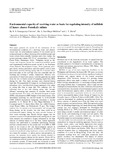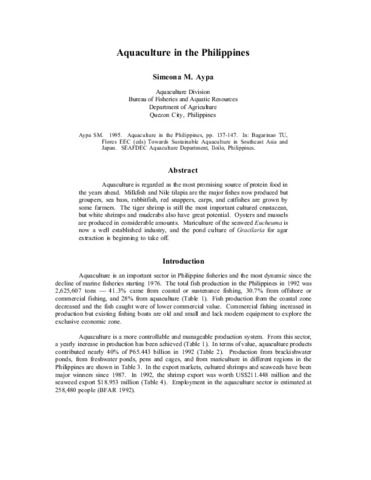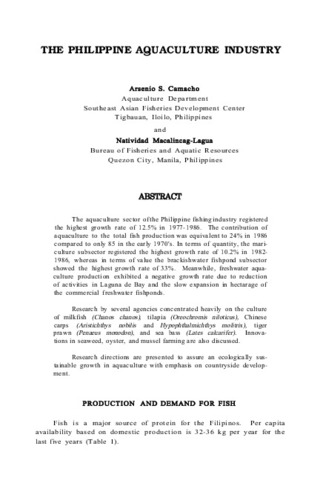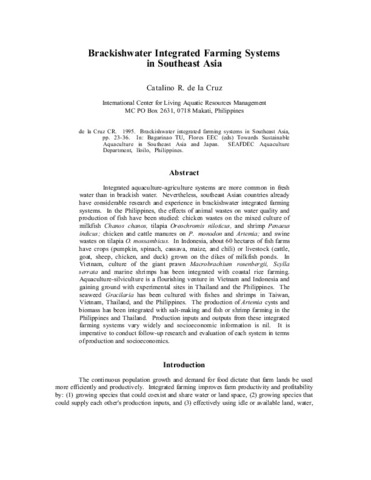Environmental capacity of receiving water as basis for regulating intensity of milkfish (Chanos chanos Forsskal) culture
Share
Abstract
This paper presents the results of the assessment of the environmental condition of a receiving water and demonstrates how the environmental capacity of the system can be estimated based on effluent discharge from milkfish ponds and water criteria from scientific literature and other studies. An estuary (average volume, 295 333 m3; average depth, 1.9 m) in Punta Pulao, Dumangas, Iloilo, Philippines served as discharge and irrigation system for commercial milkfish ponds and experimental/verification ponds owned by the Southeast Asian Fisheries Development Center. Total ammonia nitrogen, nitrite, nitrate, phosphate, and chlorophyll a (chl a) were determined monthly (during spring tide) for 4 months. Samples were taken at low and high tides that coincided with the draining and flooding of ponds, respectively. Monthly concentrations of these water quality variables generally increased from the first to fourth month of sampling (April–July 2001) during low tide. Very slight increases were observed during high tide. The magnitude of changes in the diurnal patterns of phosphate, chl a, and dissolved oxygen appeared to be higher at spring tide than at neap tide. This indicates that the inflowing river at low tide (during spring tide) brought effluents containing high amounts of nutrients from ponds located upstream. The water, salt, dissolved inorganic nitrogen (DIN), and phosphate (DIP) budgets of the entire estuary were determined following the one-box model by LOICZ-IGBP (2000, LOICZ biochemical budgeting procedure: a tutorial pamphlet. L. T. David, M. L. San Diego-McGlone, C. J. Crossland and S. V. Smith (Eds). Publ. for LOICZ International Project Office, the Netherlands, 29 pp.). The budgets indicate that the system is net heterotrophic and nitrogen (N) fixing during the dry months, but that there could be no environmental impact during the rainy months because of short water exchange time. Results further suggest that the system is a source of N and phosphorus (P) during the dry and rainy months; the condition is largely influenced by the high amount of nutrient inputs in to the river. Linear regression analysis was performed to determine relationship between nutrient concentrations in the system and total DIN or DIP input to the system at low tide. Environmental capacity in terms of the maximum amount of DIN or DIP input to the system was predicted using regression analysis and following set criteria for nutrients, i.e. nitrite, nitrate, and phosphate. At present, the estuarine water quality has already reached its environmental capacity during the dry months. About 945 ha of commercial milkfish ponds are operating upstream, mostly as extensive systems. If these ponds are converted to semi-intensive or intensive systems, it is recommended that the pond area be reduced to 122 ha if the DIP criterion is to be followed so as not to exceed the environmental capacity. Exceeding this environmental capacity may affect production through reduction of fish growth, occurrence of diseases, and fish mortalities.
Suggested Citation
Sumagaysay-Chavoso, N. S., San Diego-McGlone, M. L., & David, L. T. (2004). Environmental capacity of receiving water as basis for regulating intensity of milkfish (Chanos chanos Forsskal) culture. Journal of Applied Ichthyology , 20(6), 476-487. https://doi.org/10.1111/j.1439-0426.2004.00577.x
Subject
Taxonomic term
Collections
- AQD Journal Articles [1249]
Related items
Showing items related by title, author, creator and subject.
-
Aquaculture in the Philippines
Aypa, Simeona M. (Aquaculture Department, Southeast Asian Fisheries Development Center, 1995)Aquaculture is regarded as the most promising source of protein food in the years ahead. Milkfish and Nile tilapia are the major fishes now produced but groupers, sea bass, rabbitfish, red snappers, carps, and catfishes ... -
The Philippine aquaculture industry
Camacho, Arsenio S.; Macalincag-Lagua, Natividad (Aquaculture Department, Southeast Asian Fisheries Development Center, 1988)The aquaculture sector of the Philippine fishing industry registered the highest growth rate of 12.5% in 1977-1986. The contribution of aquaculture to the total fish production was equivalent to 24% in 1986 compared to ... -
Brackishwater integrated farming systems in Southeast Asia
De la Cruz, Catalino R. (Aquaculture Department, Southeast Asian Fisheries Development Center, 1995)Integrated aquaculture-agriculture systems are more common in fresh water than in brackish water. Nevertheless, southeast Asian countries already have considerable research and experience in brackishwater integrated farming ...




